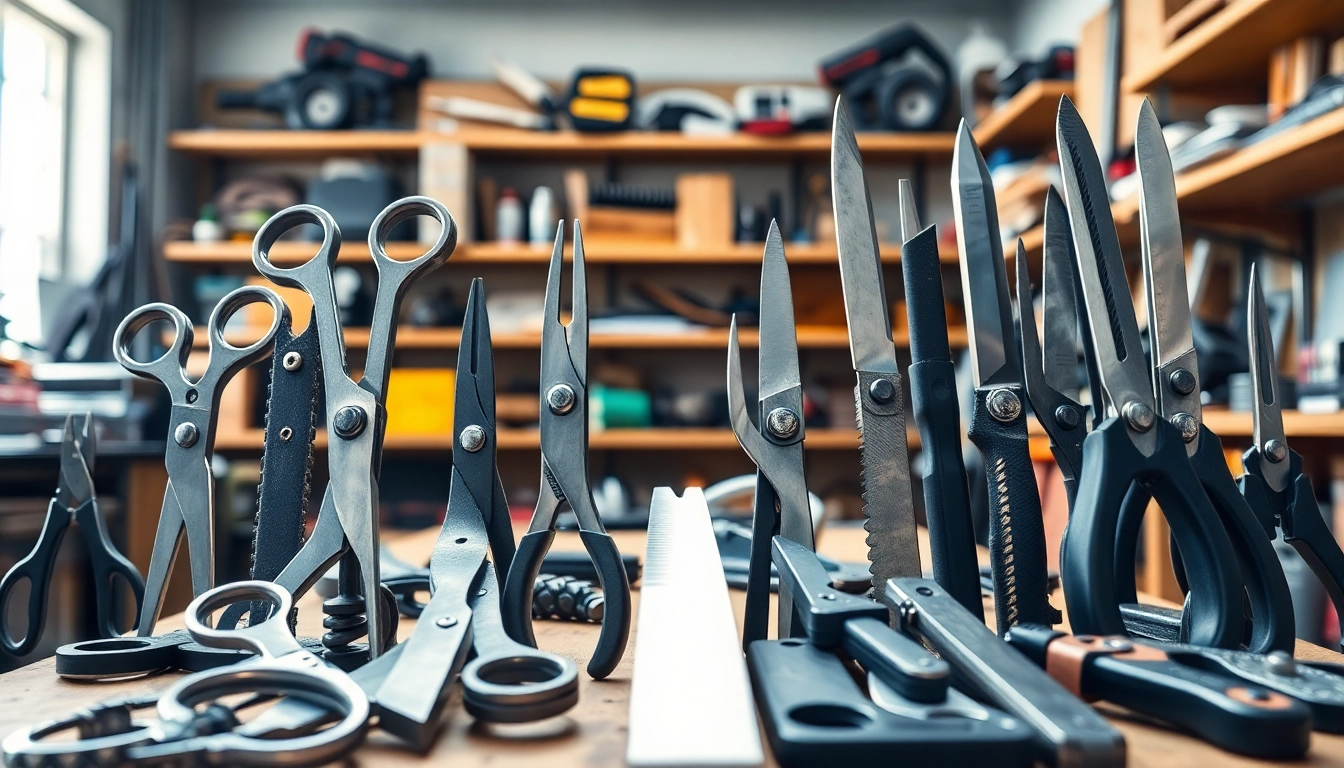Understanding Different Types of Cutting Equipment
Cutting equipment is essential across a wide range of industries, from construction and manufacturing to culinary arts and crafting. Understanding the various types of cutting tools available can greatly influence efficiency, safety, and precision in projects. From simple handheld tools to complex machinery, each type serves a distinct purpose tailored to specific materials and tasks. For those exploring options in cutting equipment, getting acquainted with the full spectrum is crucial.
Common Cutting Equipment Used in Various Industries
Different industries utilize a variety of cutting equipment tailored to their unique needs. Below are some commonly used types:
- Industrial Saws: Saws such as band saws, circular saws, and jigsaws are prevalent in construction, manufacturing, and woodworking.
- Knife Systems: These include utility knives and chef’s knives, primarily used in food preparation and culinary settings.
- Laser Cutters: Employed in manufacturing and design, laser cutting offers precision and versatility for materials ranging from metals to fabrics.
- Water Jet Cutters: Ideal for cutting hard materials, water jet cutters utilize high-pressure water streams to achieve precise cuts without altering the material’s properties.
- CNC Machines: Computer numerical control machines apply automation for cutting metals and other materials, ensuring repeatable and high-quality cuts.
Factors Influencing the Choice of Cutting Equipment
When selecting cutting equipment, several factors should be considered:
- Material Type: The characteristics of the material being cut dictate equipment choice; for hard metals, industrial saws or CNC machines are often required.
- Desired Precision: For projects requiring high precision, laser or water jet cutters may be preferred.
- Production Volume: High-volume production may merit the investment in expensive machinery to maintain efficiency, whereas smaller projects might benefit from handheld tools.
- Cost: Evaluating the budget is essential when choosing equipment; higher-end models often come with advanced features that justify the cost.
- Safety Standards: Ensuring that the equipment meets industry safety standards protects users and maintains compliance.
Advantages of Using Specialized Cutting Tools
Utilizing specialized cutting tools brings numerous benefits:
- Efficiency: Specialized tools are designed to make cuts faster and more accurately, significantly reducing production time.
- Quality: The precision offered by specialized equipment often results in cleaner cuts and better overall product quality.
- Safety: Specialized tools often incorporate safety features designed to minimize risks associated with cutting operations.
- Ease of Use: Tools optimized for specific tasks are generally easier to use, requiring less manual effort and lower skill levels for operation.
How to Maintain and Care for Your Cutting Equipment
Proper maintenance and care are vital for the longevity and performance of cutting equipment. Neglecting these aspects can lead to decreased efficiency, safety hazards, and additional costs in repairs or replacements.
Regular Maintenance Practices for Longevity
Routine maintenance practices include:
- Inspection: Regularly inspect blades and cutting edges for wear and damage, replacing them as necessary to ensure optimal performance.
- Lubrication: Keep moving parts lubricated to reduce friction, prevent wear and tear, and improve the efficiency of the cuts.
- Calibration: For machines, ensure that all settings are calibrated correctly to maintain accuracy.
- Storage: Store equipment in a clean, dry environment to prevent rust and corrosion, particularly with metal tools.
Cleaning Techniques for Different Materials
Cleaning cutting equipment varies depending on the material:
- Metal: Use mineral spirits or a degreaser to clean metal cutting equipment, followed by a thorough rinse and drying.
- Plastic: For plastic tools, warm soapy water and a soft brush can remove residue without scratching surfaces.
- Wood: Wipe wooden tools with a damp cloth and apply mineral oil periodically to maintain the wood’s integrity.
Storing Your Cutting Equipment Safely
Effective storage ensures that cutting equipment remains sharp and ready for use:
- Blade Guards: Using blade guards or sheaths can protect sharp edges from damage and prevent accidental cuts.
- Organized Storage: Keeping tools organized in a dedicated storage space reduces clutter and ensures easy access.
- Humidity Control: Use moisture control products or dehumidifiers in storage areas to prevent rust and corrosion on metal tools.
Choosing the Right Cutting Equipment for Your Project
Finding the right cutting equipment for specific projects involves careful consideration of several elements.
Assessing Your Project Requirements
Evaluate the nature of your project:
- Material: Identify the materials to be cut and the methods that work best with those materials.
- Complexity: Assess the complexity of the cuts required, which can influence the type of equipment needed.
- Budget: Determine your budget and explore equipment options within that range that meet project needs.
Comparing Features and Prices of Cutting Tools
When comparing cutting tools, consider:
- Specifications: Check the specifications such as cutting capacity, blade type, and speed features.
- Reviews: Gathering feedback from previous users through reviews and testimonials can provide insight into performance.
- Warranty: A good warranty can indicate the manufacturer’s confidence in their product and protect your investment.
Where to Buy Quality Cutting Equipment
Purchasing quality cutting equipment requires diligence:
- Authorized Dealers: Buy from authorized dealers for the respective brands to ensure genuine products and warranties.
- Online Retailers: Websites like Amazon and specialized industrial suppliers often provide a wide range of options.
- Local Stores: Visiting a local store can allow you to assess tools in person and receive expert advice.
Innovations and Trends in Cutting Equipment Technology
The cutting equipment industry is rapidly evolving, driven by technological advancements and the demand for more efficient tools. Staying informed about these innovations can enhance project outcomes.
The Impact of Technology on Cutting Equipment Efficiency
Recent advancements in technology have significantly enhanced cutting equipment efficiency:
- Automation: Machines equipped with automation technology allow for faster production cycles and reduced manual errors.
- Smart Technology: Bluetooth and Wi-Fi connectivity in modern tools enable real-time monitoring and adjustments.
- Advanced Materials: The use of ceramics and composites in blades increases durability and reduces wear.
Future Trends in Cutting Equipment Design
As consumers demand more from their tools, several trends are emerging:
- Sustainability: Eco-friendly materials and energy-efficient designs are becoming commonplace in product development.
- User-Friendly Designs: Ergonomics and usability are prioritized to cater to a wider range of users, focusing on reducing fatigue and enhancing ease of use.
- Multi-Functionality: Tools that serve multiple purposes are increasingly popular, providing versatility and reducing the need for multiple devices.
Environmental Considerations in Cutting Equipment Manufacturing
Manufacturers are increasingly taking environmental considerations into account:
- Recyclability: Equipment designed with recyclable materials helps reduce landfill waste.
- Waste Reduction: Improved production techniques focus on minimizing waste generated during manufacturing.
- Energy Source: Renewable energy sources are being utilized in manufacturing processes to lessen carbon footprints.
Training and Safety Tips for Using Cutting Equipment
Safety and proper training are paramount when working with any cutting equipment. Understanding safety protocols and techniques can prevent accidents and injuries.
Essential Safety Gear for Cutting Operations
Appropriate safety gear includes:
- Gloves: Cut-resistant gloves prevent injuries to the hands during operation.
- Eye Protection: Safety goggles shield the eyes from debris and sawdust.
- Ear Protection: For noisy equipment, earplugs or noise-cancelling headphones help protect hearing.
Proper Techniques for Using Various Cutting Tools
Proper usage techniques enhance safety and precision:
- Body Positioning: Maintain a stable stance while operating cutting tools for greater control.
- Methodical Motion: Apply steady, controlled motions to avoid jerking motions that could lead to accidents.
- Clear Work Area: Keep the workspace clear of obstacles to prevent tripping hazards.
Recognizing Potential Hazards While Working with Cutting Equipment
Be aware of common hazards:
- Loose Clothing: Avoid wearing loose clothing or jewelry that could get caught in moving parts.
- Damaged Equipment: Regularly check tools for damage, and do not operate any equipment that appears malfunctioning.
- Lack of Concentration: Stay focused during cutting operations, as distractions can lead to mistakes.



